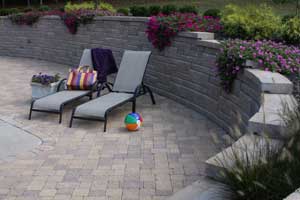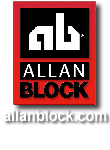What is a Retaining Wall?

Retaining Wall Planter
A retaining wall is a structure that holds or retains soil behind it. There are many types of materials that can be used to create retaining walls like concrete blocks, poured concrete, treated timbers, rocks or boulders. Some are easy to use, others have a shorter life span, but all can retain soil.
Gravity Wall or Geogrid Reinforced Wall?
Several questions must be considered in order to build the proper type of retaining wall. For example, is the soil sand, clay, or something in between? What is above the wall: a driveway or something heavier like a pool? Will the ground above or below the wall be level or sloped? What is the height of the wall? All of these factors will determine whether you will need a Gravity Retaining Wall or a Geogrid Reinforced Retaining Wall.
Gravity retaining walls are walls that depend on their own weight and setback to retain the soil and are typically shorter in height. Allan Block retaining walls are ideal for this type of wall, because as they are stacked together they lock into place to form a setback. This setback helps the wall support the pressure from the soils behind it.
Reinforced retaining walls are walls that use some type of reinforcement to give more strength to the retaining wall structure, thus improving its ability to retain the soils behind it. For SRW’s (Segmental Retaining Walls), we refer to this reinforcement as geogrid or grid. Geogrid is placed between courses of blocks in the wall and rolled back into the slope or hillside during installation to create a stronger and more stable soil mass. In layman’s terms, the blocks, the geogrid and the reinforced soil mass work together to make one large, heavy retaining wall structure. Sometimes grid is not a usable solution on a project due to space or other site conditions, so alternative reinforcement materials need to be used – such as no-fines concrete, soil nails or earth anchors. These types of reinforcement typically require a local engineer for the design and a certified contractor for the installation
Types of Retaining Walls

Retaining Wall
Over the years many different retaining wall materials have helped to alter the landscape in which we live. Common retaining wall products include railroad ties or treated timbers as well as wall stones, natural stones, bricks and concrete block.
While wood is often an inexpensive and simple choice for a retaining wall, its short lifespan makes it a relatively poor choice. As the wood decomposes, so does your retaining wall and the integrity of your usable space. Stones, rocks or boulders can create beautiful retaining walls, but the installation of these materials can be expensive and labor intensive. Furthermore, maintenance of stone walls can be difficult, because over time or they may erode or become home to rodents and weeds.
Cast-in place or mortared retaining walls are another option. These walls can be installed with a variety of veneers, bricks, flagstones, etc. which add texture and style. However, these structures are rigid and do not move and flex with climate changes, earthquakes and other natural forces, and can be very expensive to build.
SRW’s (Segmental Retaining Walls) like the Allan Block products, offer concrete masonry blocks that are modular and interlocking for ease of use. Simply stack the mortarless blocks together using our installation information, and create a maintenance-free retaining wall that will add usable land, fix a grading or slope issue, and solve many other site problems. These SRW’s use similar construction techniques as found in the mortarless construction of the Great Wall of China and the Pyramids of Egypt and will stand the test of time. SRW’s come in a variety of sizes, shapes and colors as well as different facing textures. Some of the more common textures offer a hard-split or soft-split look, a tumbled look, or more recently a stamped face. Concrete blocks made out of recycled materials are also available. Once you build a wall with an SRW – you can be sure it is built to last.

